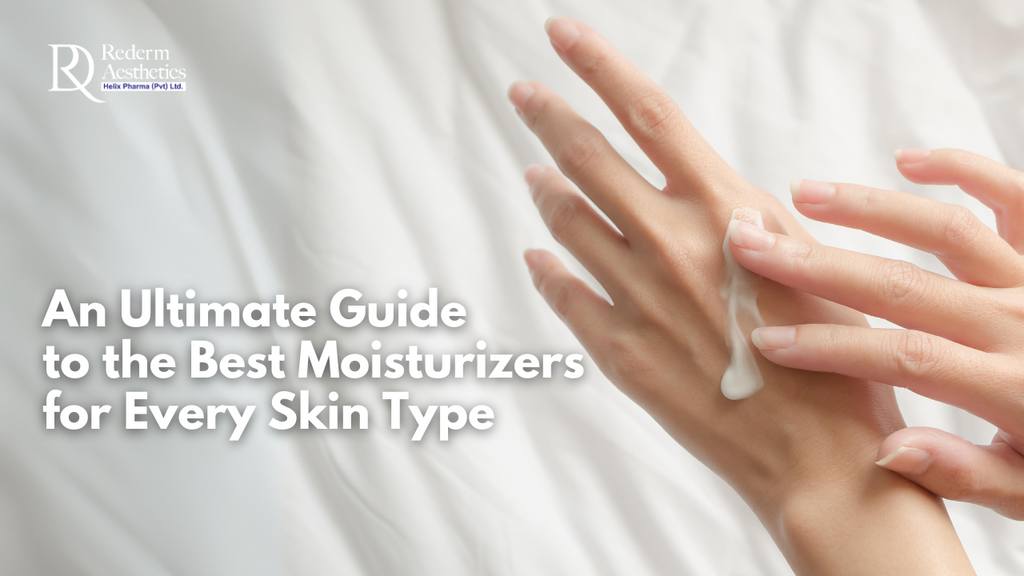An Ultimate Guide to the Best Moisturizers for Every Skin Type

There seems to be a consensus among the general population regarding moisturizers- that daily moisturizing is not necessary for healthy skin but rather an aesthetically inclined habit. On the contrary, the skin is actually our body’s most sensitive organ and requires the right kind of attention to stay healthy and look your best.
The real challenge though, is finding the perfect moisturizer, especially when every product claims to be the best. Every individual’s skin is different, and every skin type has its own unique needs. The first step is to figure out what your skin type really is- normal, oily, dry, combination, or sensitive. With a little guidance, you can find the best moisturizer tailored to your needs, and this ultimate guide will help you do just that.
Why Moisturizing is Important
First, it’s important to understand why moisturizing is actually so important for the skin, and this reasoning applies regardless of skin type:
- Maintains Hydration: All skin needs hydration to be balanced and perform its functions optimally, even if it appears oily. In fact, dehydrated skin often results in the overproduction of oil as a compensatory mechanism.
- Protects the Skin Barrier: A quality moisturizer helps strengthen the skin’s natural barrier, hence keeping harmful pollutants and irritants out while keeping moisture in.
- Prevents Skin Issues: As mentioned, the skin is an extremely sensitive organ and without appropriate hydration, it becomes prone to irritation, premature aging, and sensitivity, all of which can be prevented with consistent use of a moisturizer.
Now that you understand the importance of moisturizing, it’s useful to figure out what your skin type is, and how to choose the best face moisturizer for your skin’s needs.
How to Identify Your Skin Type
Figuring out your skin type is the first step in choosing the best face moisturizer. To determine yours, start with freshly cleansed skin.
Wash your face with a gentle cleanser such as the Clariderm Anti-Acne Face Wash and pat dry, then wait for about an hour before applying any products. After the hour, observe how your skin feels and looks.
If it feels tight or appears flaky and dull, you likely have dry skin. Flakes may be a symptom oof sensitive skin, but this type has additional symptoms too.
If it looks shiny and feels greasy in most areas shortly after washing your face, your skin is likely oily. Such skin has visible pores and is also prone to breakouts.
If you notice shine primarily in your T-zone (the forehead, nose, and chin) but dryness elsewhere, you probably have combination skin.
If your skin feels comfortable and balanced without excessive oil or dryness, you likely have normal skin.
Any of these types can also be prone to sensitivity. Sensitive skin is usually determined by frequent irritation, redness, itching, or reactions after using certain products.
Once you’ve identified your skin type, you can choose the right moisturizer, suitable to your unique needs.

Types of Ingredients to Look For in a Moisturizer
Moisturizers can generally be categorized based on their key ingredients:
- Humectants: Ingredients like hyaluronic acid and glycerin attract moisture from the environment and help bind it to your skin.
- Emollients: These ingredients, such as fatty acids, ceramides, and plant oils, smooth the skin and fill in the gaps between skin cells, creating a soft, smooth texture.
- Occlusives: Ingredients like petrolatum and beeswax create a barrier over your skin, sealing in moisture to prevent water loss.
A quality moisturizer will typically include a mix of these ingredients, but the perfect formulation for you will depend on your skin type.
Tips for Dry Skin
Dry skin craves deep, long-lasting hydration. This type of skin often feels tight or rough, especially in colder weather, so choosing a thick, nourishing moisturizer is crucial.
Key Features to Look For:
- Creamy or balm-like texture
- Hydrating ingredients like glycerin, hyaluronic acid, and ceramides
- Occlusive agents to lock in moisture
For dry skin, choose a moisturizer with a rich, creamy texture that provides deep hydration. Ingredients like hyaluronic acid will attract water to your skin, while emollients and occlusives will help lock in that moisture. Specifically, look for formulations with ceramides, triglycerides, and panthenol to keep your skin hydrated all day, even in dry climates or during the colder months.
For severe dryness, petrolatum-based moisturizer might be needed for that extra oomph. Moreover, for extra hydration, consider layering a hydrating serum underneath your moisturizer to help lock in hydration for longer. The Hydra FX Moisturising Serum especially, because of the hyaluronic acid, can help attract and retain moisture in the skin and can work with your moisturizer to address the dryness effectively.
Tips for Oily and Acne-Prone Skin
Oily and acne prone skin can be lumped together because the acne is usually a result of the sebum (an oily substance produced by the skin) clogging the pores and resulting in acne. The goal in such a case is to hydrate without adding extra shine or clogging pores. This step might seem useless for such skin types, but skipping moisturizer can cause your skin to produce even more oil to compensate for dehydration.
Key Features to Look For:
- Lightweight, oil-free formulas
- Non-comedogenic (does not clog pores)
- Hydrating ingredients like glycerin and hyaluronic acid
Opt for lightweight moisturizers with hyaluronic acid, ceramides, and glycerin to hydrate the skin without overwhelming it. Make sure to select non-comedogenic products to avoid triggering breakouts while trying to moisturize.
Tips for Combination Skin
Combination skin is characterized by both oily areas and dry patches on other parts of the face and is the most common skin type people experience. The challenge here for such a skin type is balancing hydration without making oily areas feel greasy or worsening the dryness.
Key Features to Look For:
- Balancing formulas that address both oily and dry areas
- Lightweight but formulated hydrating ingredients
- Non-comedogenic to avoid clogging pores in oily areas
Instead of using different moisturizers for different needs, find a lightweight moisturizer that hydrates without overwhelming the oilier areas of your skin. Look for ingredients like hyaluronic acid, which can hydrate your skin without making it feel greasy or heavy.
Tips for Sensitive Skin
Sensitive skin can be reactive to ingredients like fragrances, alcohol, or any harsh substances. Finding a gentle, soothing moisturizer is key to calming irritation and redness while still giving you that much-needed hydration.
Key Features to Look For:
- Fragrance-free, hypoallergenic formulas
- Soothing, non- toxic ingredients like aloe vera
- Lightweight and non-greasy
Seek out moisturizers specifically formulated for sensitive skin that are free from potential irritants like fragrance, alcohol, and parabens. Soothing ingredients can help calm the skin and prevent irritation while delivering a burst of hydration.
Best Moisturizers for Normal Skin
If you have normal skin, you’ve hit the skincare jackpot! Normal skin is generally well-balanced in terms of oil production and hydration. The key is to maintain that balance with a moisturizer that keeps your skin healthy without being too heavy or too light.Key Features to Look For:
Lightweight but effective hydration
- Non-greasy formulas
- A blend of humectants and emollients to maintain moisture
Look for moisturizers that maintain hydration without being overly heavy on the skin. Choose a light to medium-weight moisturizer with a good mix of hydrating ingredients like glycerin or hyaluronic acid, and skin-softening emollients. This will keep your skin soft, smooth, and glowing.
Best Hydration Moisturizer for All Skin Types
Now that we have established that all skin types definitely need moisturizer, the challenge is choosing the best one.
The Hydra FX Moisturising Cream is a dermatologist recommended moisturizer expertly formulated to address various skin concerns and suit a wide range of skin types, making it the perfect all-rounder. It is a lightweight, fast absorbing that hydrates, repairs, protects, and strengthens the skin barrier.

How It Works For Each Skin Type:
Dry Skin
For those with dry skin, the white soft paraffin and light liquid paraffin create a protective barrier that seals in moisture, while sodium hyaluronate delivers the hydration that helps combat dryness and prevent flaky, rough patches. The added aloe vera extract soothes dry or irritated skin, making it feel soft and nourished all day.
Oily and Combination Skin
This formula has been specifically designed to be lightweight and non-greasy, making it suitable for oily skin as well. As mentioned, the sodium hyaluronate and aloe vera extract provide hydration without clogging pores, and the moisturizer absorbs quickly without leaving a heavy or greasy feeling, which is crucial for oily or combination skin types.
Sensitive Skin
This moisturizer ticks all the right boxes, providing the gentle care required, which is why it is also dermatologist recommended. The absence of harsh ingredients and the presence of ceramides make this ideal for maintaining and restoring the skin’s natural barrier. The soothing aloe vera extract works wonders in calming any redness or irritation, making it perfect for those with reactive skin.
Normal Skin
For normal skin types, this moisturizer provides just the right balance of hydration and protection. The ceramides help maintain the skin’s natural barrier, while aloe vera extract and wheat germ oil keep the skin feeling soft, fresh, and healthy. Plus, the addition of SPF 30 means normal skin can enjoy daily sun protection without having to layer multiple products.
P.S. Applying sunscreen before moisturizing is still important because its key for protecting your skin from UV damage, and helping prevent aging and discoloration, while a quality moisturizer targets the other skin concerns. So why not use one that gives you both benefits like this moisturizing cream.
How to Apply Moisturizer for Maximum Benefit
Now that we’ve discussed in detail how to figure out which moisturizer is the best for your skin type, it’s important to know how to use it correctly as well.
Apply moisturizer immediately after cleansing, ideally while your skin is still slightly damp, to help lock in moisture effectively. Moreover, you should also apply moisturizer twice daily- once in the morning and once at night- to keep your skin properly hydrated.
A Simple Moisturizing Routine:
- Cleanse: Start with a gentle cleanser that suits your skin type.
- Serum (optional): If you use a serum, apply it before your moisturizer.
- Moisturize: Apply your chosen moisturizer while your skin is still slightly damp to seal in hydration.
- SPF (morning routine): Don’t forget to use sunscreen during the day to protect your skin from UV damage.
Conclusion
Choosing the best moisturizer for your skin type is all about understanding your skin’s unique needs. Whether you have oily, dry, combination, sensitive, or normal skin, the key is to look for formulas with the right ingredients to support your skin’s health.
With a well-chosen moisturizer such as the Hydra FX Moisturising Cream and proper application, you can maintain soft, glowing, and healthy skin! Pair this with any of the wide range of products available at Rederm Aesthetic to really help your skin look and feel its best.
-
Posted in
Acne care face wash, Acne Cleanser Facewash, acne face wash, acne face wash for oily skin, acne face wash in pakistan, acne face wash price in pakistan, acne serum in pakistan, Anti Dandruff Serum, anti hair fall serum, anti hair fall serums, Anti Hair Fall Shampoos in Pakistan, Anti-Acne Face Wash, Anti-ageing Serum, Anti-Dandruff Shampoo, anti-dandruff treatment, Anti-Fatigue Night Cream, anti-hair fall serum in Pakistan, Anti-hair fall shampoos, best acne face wash in Pakistan, best ant-hair fall serum in Pakistan, best anti acne face wash in Pakistan, best anti acne serum in pakistan, best anti dandruff shampoo in pakistan, best Brightening Serum in Pakistan, best face wash, best face wash for acne, best face wash for acne and pimples in pakistan, best face wash for acne in pakistan, best face wash for men, best medicated acne cream in pakistan with price, best moisturiser for oily combination skin, best moisturizer, best moisturizer for acne prone skin in pakistan, best moisturizer for dry skin, best moisturizer for dry skin in pakistan, best moisturizer for men oily skin, best moisturizer for oily skin, best moisturizer for oily skin in pakistan, best moisturizer in Pakistan, best moisturizer oily skin, best night cream in Pakistan, best night creams in Pakistan, best procapil spray in Pakistan, best serum for dark spots in pakistan, best serum for glowing skin, best serum for pigmentation in pakistan, best serum for two tone skin, Best serum for uneven skin tone in Pakistan, best shampoo for dandruff and hairfall in pakistan, best shampoo for hair fall in pakistan, best shampoo for hair growth in pakistan, best skin brightening cream, best skin brightening serum, best skin care products in pakistan, best sunblock, best sunblock in Pakistan, best sunscreen for dry skin, best sunscreen for face, best sunscreen for oily skin, best vitamin c serum for face, best whitening night cream in pakistan, best whitening serums in Pakistan, Brightening & Depigmentation Cream, Brightening and Depigmentation Serum, dandruff hair loss shampoo, depigmentation cream, depigmentation serum, dermatologist approved hair products, Dermatologist recommended face wash in Pakistan, dermatologist-recommended night creams, Dryness Skin Cream, face sunblock spf 100, face wash for acne prone skin, face wash for dry skin, face wash for oily skin, facewash for Sensitive Skin, facewash price in Pakistan, Hair care, hair care Product in Pakistan, Hair Care Products, hair fall spray in Pakistan, hair regrowth serum in Pakistan, Hair Regrowth Shampoo, hair regrowth shampoo in Pakistan, hair regrowth shampoos, Hair Regrowth Shampoos in Pakistan, hair serum for dandruff, Healthy skin in Ramadan, hydrex cream, Ingredient of Anti-Dandruff Shampoo, medicated acne face wash, medicated anti dandruff shampoo, Medicated Anti-acne face wash, Medicated face wash in Pakistan, medicated moisturizer in pakistan, medicated shampoo for dandruff, medicated skin care products in pakistan





